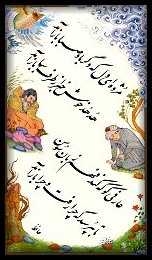 |
The Development
(This entire section has been taken from the book "Persian Literature", 'Columbia Lectures on Iranian Studies 3'. Art Arena is indebted to Ehsan Yarshater for his permission to include parts of the "Introductory Survey" from this informative book.)Historical Perspective: In the course of the seventh century Persia was overrun by victorious Muslim armies, and the Sassanian Empire (AD 226-652), fabled for the splendor of its court, crumbled. The conquest proved to be far more than military, for it introduced a new religion into Persia and opened an entirely new chapter in Iranian history. The country whose soldiers had subdued faraway Yemen, captured Jerusalem, and marched to the gates of Constantinople only a few decades earlier, now came under the aegis of the caliphs and was ruled by Arab governors for some two hundred years before it could assert its identity again. In the meantime the majority of the Persians, particularly in urban centers, converted to Islam. With conversion came a new spirit and a new social order. As the unity of the overwhelming and transcendent Allah was impressed upon the converts, the characteristic belief in the dualism of the Iranian religion disappeared. Gone too, were the class distinctions, which had been the backbone of Sassanian social and political organization. The powerful Zoroastrian church was reduced to a marginal institution catering to the spiritual needs of a declining community.... ....The Islamization of Persia brought about such deep and enduring transformations in the life and culture of the country that some Persians began to regard their pre-Islamic past as a pagan era which had ended with the fall of the Sassanian Empire . The advent of Islam indeed marked a unique turning point in the life of the Persian people; however, it would be an error to view the change as too drastic. There were powerful links between the pre- and post-Islamic eras of Persian history. Changes which appeared radical at first, proved to be less trenchant as the old habits and traditional modes of thought returned in a new guise. Many of the old religious beliefs and practices found a home within "Iranian Islam," to borrow Henry Corbin's phrase. Popular religion, in particular, preserved many aspects of old religious thought and practice, albeit with different terminology. People continued to expect a savior who would rise one day, punish the wicked, and fill the world with justice.... ....The most effective link between the two periods of Persian history, however, was a linguistic one. Most of the countries that were conquered by the Arab armies in the first century of Islam, when the new religion was at the height of its drive, lost their language to Arabic and eventually shed their previous identities, becoming "Arab." Such was the case with Iraq, Syria, Egypt, and much, of North Africa. Persia was a notable exception: although conquered completely and absorbed inextricably into the Muslim world, it nonetheless retained its language and its identity. The Sassanians had strongly promoted the language of their homeland Persis (Fars), making it the official tongue of their Empire. This language, called Middle Persian in modern scholarship, continued to be used in Iran after the Islamic conquest; it underwent some gradual changes and emerged in the ninth century as the language of a "renaissance" in Persian literature. In the process, its grammar had become simpler, it had borrowed some vocabulary from Arabic, and it had shed a number of words with Zoroastrian connotations or else adapted such words to the prevailing Islamic environment. It is through this later language, called New Persian (or simply Persian) that the literary gifts of the Iranians found their major channel of expression. The term "renaissance" implies an earlier period of literary activity, and indeed the early Persian poets and writers owed much to the literature which had, flourished in pre-Islamic Iran. The greatest monument of Persian language and literature, the Shah-nama (Book of kings) by Ferdowsi (completed ca. AD 1000), although the work of a literary genius, is in substance the reworking of the national saga compiled and committed to writing in Middle Persian toward the end of the Sassanian period.... The following chapters provide an insight into "The Development of Iranian Literatures":Copyright shall at all times remain vested in the Author. No part of the work shall be used, reproduced, stored in a retrieval system, or transmitted in any form or by any means electronic, mechanical, photocopying, recording or otherwise, without the Author's express written consent. Copyright © 1999 K. Kianush, Art Arena |
||||||||||||||||||||||
